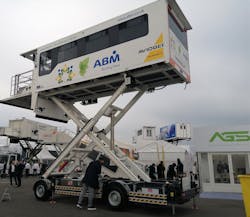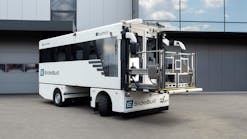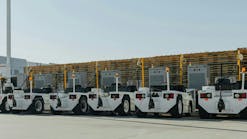Aviogei Introduces Hydrogen Hybrid Powertrain
At the GSE Expo Europe, Aviogei presented a small-scale prototype of a hydrogen hybrid powertrain developed for ground support equipment.
The hydrogen powertrain, which will be installed on a vehicle for passengers with reduced mobility (PRM) is being carried out in collaboration with the Industrial Electronics Laboratory of the Electrical and Information Engineering Department at the University of Cassino and Southern Latium.
“Hydrogen will play a key role in the transition to renewable energy sources,” says Andrea Cesarini, CEO at Aviogei Airport Equipment. “It is the best choice for at-scale decarbonization, as it is an inexhaustible source that can be produced from many sources and has a high-energy power – about 2.5 times more than methane. Aviogei has contact in progress with Italian airports that have ongoing hydrogen projects.”
Along with the University of Cassino, Aviogei began a project for hydrogen propulsion equipment in 2013. But at that time, it was too early for the technology to be accepted at airports, Cesarini explains.
“Now the landscape has totally changed and airports are already organizing an appropriate infrastructure for the accumulation of hydrogen cells,” he says, noting some Italian airports have launched green hydrogen storage and distribution initiatives.
As a member of H2IT, Aviogei is focused on the development of hydrogen-powered solutions. H2IT is the Italian Hydrogen and Fuel Cells association, which brings enterprises, research centers, universities, technology clusters and local entities together to work in the hydrogen sector in Italy.
“H2IT aims at stimulating the creation of the infrastructure for the use of hydrogen, ensuring a leadership role for Italy in the international market. We have also partners for the fuel cells and we are collaborating with lab research,” he says.
Still in the development phase, Aviogei’s first goal has been to achieve the feasibility and performance of a hybrid propulsion system powered by hydrogen and lithium polymer batteries. From there, Cesarini says the goal is to expand offerings and further support customers’ decarbonization efforts.
“The project will have an important impact on the decarbonization of the airport industry, contributing to the achievement of the objectives of the airports committed to the net zero targets,” he adds. “In particular, the European aviation industry is strongly committed to reaching net zero CO2 emissions and contribute to the goals set in the European Green Deal and the Paris Agreement.”
While this initial hydrogen project has been applied to a PRM vehicle, Cesarini says the company intends to extend the use of the technology to all of its GSE production.
“We have detected interest in this new technology and in our programs,” he concludes.







